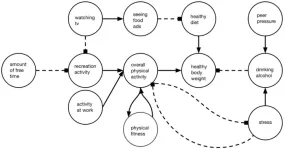(Press-News.org) BUFFALO, N.Y. – Industry has long relied upon energy-intensive processes, such as distillation and crystallization, to separate molecules that ultimately serve as ingredients in medicine, chemicals and other products.
In recent decades, there has been a push to supplant these processes with membranes, which are potentially a lower-cost and eco-friendly alternative. Unfortunately, most membranes are made from polymers that degrade during use, making them impractical.
To solve this problem, a University at Buffalo-led research team has created a new, sturdier membrane that can withstand harsh environments – high temperatures, high pressure and complex chemical solvents – associated with industrial separation processes.
Made from an inorganic material called carbon-doped metal oxide, it is described in a study published Sept. 7 in Science.
“The processes of separating molecules – whether for water desalination, the production of medicine or fertilizers – use an incredible amount of energy,” says the study’s corresponding author, Miao Yu, PhD, SUNY Empire Innovation Professor in the Department of Chemical and Biological Engineering in the University at Buffalo School of Engineering and Applied Sciences.
“What we have developed is a technique to easily fabricate defect-free, strong membranes that have rigid nanopores that can be precisely controlled to allow different-sized molecules to pass through,” adds Yu, a core faculty member in the UB RENEW Institute.
The study’s first authors are Bratin Sengupta, a PhD student in Yu’s lab, and Qiaobei Dong, PhD, who studied under Yu and now works at GTI Energy.
Inspired by semiconductors
To create the membrane, the research team took inspiration from two common, but unrelated, manufacturing techniques.
The first is molecular layer deposition, which involves layering thin films of materials and is most often associated with semiconductor production. The second technique is interfacial polymerization, which is a method of combining chemicals that is commonly used to create fuel cells, chemical sensors and other electronics.
“These methods are not new,” says Sengupta, “however the manner in which we apply them is, and that is the key to creating our new nanoporous membranes.”
In experiments, researchers merged two low-cost reactants – liquid ethylene glycol and gaseous titanium tetrachloride – on an aluminum-based support. Within minutes, the reaction created a thin-film.
To create the nanopores, they applied heat to the film. The heat burns off carbon, creating tiny, microscopic holes for molecules to pass through. The size of the nanopores can be anywhere from 0.6 to 1.2 nanometers in diameter – as determined by the calcination gas environment, as well as the amount and duration of heat.
The method allows researchers to avoid a nagging problem – small holes merging into larger ones, thus making them more porous than intended – with creating polymer-based membranes.
Potential to reduce carbon footprint
The new membrane can withstand temperatures up to 284 F (140 C) and pressures up to 30 atmospheres when exposed to organic solvents. These attributes are key because they allow the membrane to separate molecules at high temperatures (for most polymer membranes to work, the temperature of the solvents must be lowered, which is costly from an energy standpoint).
“From this point of view, our membrane has the potential reduce the carbon footprint of many industrial processes,” Yu says.
To demonstrate the membrane’s effectiveness, the team showed it could separate boscalid, a fungicide used to protect crops, from its catalyst and starting reagent. The entire process occurred at 194 F.
The team is planning additional experiments to prove the membrane is capable of being scaled up for commercial products. Additionally, Yu plans to start a company to further the technology’s commercial viability.
Additional co-authors come from the Department of Mechanical and Aerospace Engineering in the University at Buffalo School of Engineering and Applied Sciences, and Rensselaer Polytechnic Institute.
The work was supported by the National Science Foundation, the Department of Energy and UB.
END
Separating molecules requires lots of energy. This new, heat-resistant membrane could change that
The technology could lower costs for making pharmaceuticals, agrochemicals and other products
2023-09-27
ELSE PRESS RELEASES FROM THIS DATE:
MSU works to make drinking water safer by fighting contaminants
2023-09-27
EAST LANSING, Mich. – Providing safe drinking water was a great public health achievement in the 20th century, yet problems persist. According to the Centers for Disease Control and Prevention, about 7.15 million waterborne illnesses occur in the United States annually resulting in 601,000 emergency room visits, 6,630 deaths and $3.33 billion in direct health care costs. Michigan State University, a world leader in water research, is working to make our drinking water safer.
MSU has been awarded a $2.1 million grant from the U.S. Environmental Protection ...
Want to make better decisions? Ask for less information, not more
2023-09-27
When people have to make a tough decision, their first instinct is usually to gather as much information as possible. Just one problem: according to research published this week in Cognitive Research: Principles and Implications, most people’s decision-making actually gets worse, not better, when you give them additional facts and details.
“It’s counterintuitive, because we all like to think we use information wisely to make smart decisions,” said Farber Chair Associate Professor ...
HMS researcher to lead $104 million federal project tackling antibiotic resistance
2023-09-27
At a glance:
Johan Paulsson, HMS professor of systems biology, will lead project studying bacterial behavior and antibiotic resistance.
Efforts will focus on developing technology to improve diagnosis, speed discovery of new antibiotics, and illuminate basic mechanisms of bacterial behavior.
Harvard Medical School researcher Johan Paulsson will lead a multi-institutional $104 million effort to study bacteria and antibiotic resistance, the U.S. Department of Health and Human Services announced today.
The work is funded by the newly established Advanced Research Projects Agency for Health (ARPA-H) in an ...
Study provides new look at why rare cancer often evades treatments
2023-09-27
BOSTON - Researchers at Boston Medical Center and Dana-Farber Cancer Institute conducted one of the first-ever analyses of neuroendocrine tumors (NETs) at single cell resolution, unlocking new insights into this rare and often hard-to-treat cancer. The findings represent a tremendous leap forward in understanding why these tumors are largely resistant to immunotherapy and provide key insights that could lead to future treatments.
“This study was a tour-de-force that catalyzed the efforts and innovations of researchers across Boston – including Boston Medical Center and Dana-Farber Cancer Institute - and has resulted in a better understanding ...
Opportunities to improve lung cancer care for older patients
2023-09-27
“With the majority of lung cancer patients being older than 65, it is imperative that actions are taken to encourage and facilitate clinical trials among older patients.”
BUFFALO, NY- September 27, 2023 – A new editorial paper was published in Aging (listed by MEDLINE/PubMed as "Aging (Albany NY)" and "Aging-US" by Web of Science) Volume 15, Issue 17, entitled, “Promising trends in lung cancer care, but are we overlooking the majority?”
In their new editorial, ...
Reassessing COVID-19 precautions in 2023
2023-09-27
“The balance between appropriate precautions and the harm of social isolation always requires a thorough appraisal.”
BUFFALO, NY- September 27, 2023 – A new editorial paper was published in Oncotarget's Volume 14 on September 22, 2023, entitled, “Reassessing the risks and benefits of COVID-19 precautions in 2023.”
The COVID-19 pandemic has killed over one million Americans with many dying during the Omicron wave. By now most Americans have either had COVID-19 and/or been vaccinated against it. Despite the availability of updated immunizations, only 16.7% of Americans are now up-to-date on bivalent ...
Is a longer reproductive lifespan good for your brain?
2023-09-27
EMBARGOED FOR RELEASE UNTIL 4 P.M. ET, WEDNESDAY, SEPTEMBER 27, 2023
MINNEAPOLIS – People with a higher cumulative estrogen exposure throughout their life may have a lower risk of cerebral small vessel disease, according to a new study published in the September 27, 2023, online issue of Neurology®, the medical journal of the American Academy of Neurology.
Cerebral small vessel disease, a form of cerebrovascular disease, results from damage to small blood vessels in the brain. It raises the risk of cognitive impairment and dementia.
“Previous research has shown that rates of cerebrovascular disease increase after menopause, which is often attributed ...
Exposure to air pollution linked to increased risk of stroke within 5 days
2023-09-27
EMBARGOED FOR RELEASE UNTIL 4 P.M. ET, WEDNESDAY, SEPTEMBER 27, 2023
MINNEAPOLIS – Short-term exposure to air pollution may be linked to an increased risk of stroke, according to a meta-analysis published in the September 27, 2023, online issue of Neurology®, the medical journal of the American Academy of Neurology. Short-term exposure was defined as occurring within five days of the stroke.
“Previous research has established a connection between long-term exposure to air pollution and an increased risk of stroke,” said study author Ahmad Toubasi, MD, of the University of Jordan in Amman. “However, the correlation between short-term ...
Microplastics are found in cave water and sediment, says SLU research
2023-09-27
In two recent papers, Saint Louis University researchers report finding high concentrations of microplastics present in a Missouri cave system that had been closed to human visitors for 30 years.
Elizabeth Hasenmueller, Ph.D., associate professor of Earth and Atmospheric Sciences and associate director of the WATER Institute at SLU, and her team published findings in the journals, Science of the Total Environment and Water Research, finding significant microplastic levels in Cliff Cave in Saint Louis County, Missouri.
The research, which originated from Hasenmueller’s research group and Karst Hydrology class, allowed students on the ...
Genetic variation with MASLD reveals subtypes and potential therapeutic avenues
2023-09-27
An astounding 30% of Americans currently have metabolic dysfunction-associated steatotic liver disease, or MASLD, which is formerly known as nonalcoholic fatty liver disease, or NAFLD.
And many are unaware that they have it.
Over time, MASLD can lead to cirrhosis, liver failure and even liver cancer. The disease is also associated with and might be caused by factors that contribute to obesity, diabetes, high cholesterol and heart disease.
“Many people are not aware that MASLD can also be a sign of another condition, like diabetes or cardiovascular disease,” said Elizabeth Speliotes, M.D., Ph.D., M.P.H., gastroenterologist at Michigan Medicine ...
LAST 30 PRESS RELEASES:
Numbers in our sights affect how we perceive space
SIMJ announces global collaborative book project in commemoration of its 75th anniversary
Air pollution exposure and birth weight
Obstructive sleep apnea risk and mental health conditions among older adults
How talking slows eye movements behind the wheel
The Ceramic Society of Japan’s Oxoate Ceramics Research Association launches new international book project
Heart-brain connection: international study reveals the role of the vagus nerve in keeping the heart young
Researchers identify Rb1 as a predictive biomarker for a new therapeutic strategy in some breast cancers
Survey reveals ethical gaps slowing AI adoption in pediatric surgery
Stimulant ADHD medications work differently than thought
AI overestimates how smart people are, according to HSE economists
HSE researchers create genome-wide map of quadruplexes
Scientists boost cell "powerhouses" to burn more calories
Automatic label checking: The missing step in making reliable medical AI
Low daily alcohol intake linked to 50% heightened mouth cancer risk in India
American Meteorological Society announces Rick Spinrad as 2026 President-Elect
Biomass-based carbon capture spotlighted in newly released global climate webinar recording
Illuminating invisible nano pollutants: advanced bioimaging tracks the full journey of emerging nanoscale contaminants in living systems
How does age affect recovery from spinal cord injury?
Novel AI tool offers prognosis for patients with head and neck cancer
Fathers’ microplastic exposure tied to their children’s metabolic problems
Research validates laboratory model for studying high-grade serous ovarian cancer
SIR 2026 delivers transformative breakthroughs in minimally invasive medicine to improve patient care
Stem Cell Reports most downloaded papers of 2025 highlight the breadth and impact of stem cell research
Oxford-led study estimates NHS spends around 3% of its primary and secondary care budget on the health impacts of heat and cold in England
A researcher’s long quest leads to a smart composite breakthrough
Urban wild bees act as “microbial sensors” of city health.
New study finds where you live affects recovery after a hip fracture
Forecasting the impact of fully automated vehicle adoption on US road traffic injuries
Alcohol-related hospitalizations from 2016 to 2022
[Press-News.org] Separating molecules requires lots of energy. This new, heat-resistant membrane could change thatThe technology could lower costs for making pharmaceuticals, agrochemicals and other products


